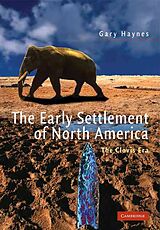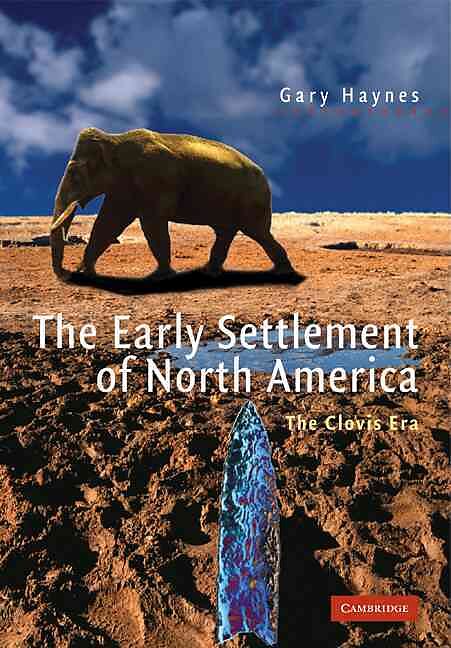The Early Settlement of North America
Einband:
Kartonierter Einband
EAN:
9780521524636
Untertitel:
The Clovis Era
Autor:
Gary Haynes, Haynes Gary
Herausgeber:
Cambridge University Press
Anzahl Seiten:
360
Erscheinungsdatum:
28.04.2009
ISBN:
0521524636
Informationen zum Autor Gary Haynes is Foundation Professor of Anthropology at the University of Nevada, Reno. For eight years (20032011) he was President of the Commission on Palaeoecology and Human Evolution in INQUA (the International Union for Quaternary Research). He has done fieldwork research on free-roaming elephants in southern Africa for over 30 years, and has also specialized in the study of earliest American Paleoindian cultures. Current research is focused on Zimbabwean prehistory and paleoenvironments. Klappentext Haynes uses extensive data to provide a compelling new integrated theory on the Clovis era. Zusammenfassung In his compelling book on the Clovis era! Gary Haynes makes extensive use of data and interpretations from archaeology! ethnography! palaeontology! and modern biology to produce a fully developed new integrated theory on the very oldest migration of human beings into North America. Inhaltsverzeichnis Part I. Fluted Points and the Peopling of the Americas: 1.1. Introduction; 1.2. Fin de siècle paradigm-busting, or what's at stake in the debate about the colonizing of North America?; 1.3. How do archaeologists address the big unanswered questions about Fluted-Point-Makers?; Part II. What is Clovis? The Archaeological Record: 2.1. Introduction; 2.2. Clovis archaeological footprints, region by region; 2.3. Knowledge and guesswork about the late Pleistocene; 2.4. Defining Clovis: is it a culture? 2.5. The course of regional developments: the megamammal connection; Part III. Clovis Archaeological Culture: 3.1. Introduction; 3.2. Clovis-era technology; 3.3. Clovis-era megamammal bone-breakage; 3.4. Clovis-era artwork, decorative work, 'symbolic' objects; Part IV. The Old and New World Patterns Compared: 4.1. Dispersals and diffusions: old world Upper Paleolithic and new world Clovis; 4.2. The American Upper Paleolithic; Part V. Figures in the Landscape: Foraging in the Clovis Era: 5.1. Introduction; 5.2. Archaeological evidence about hunting and gathering in megamammal landscapes; 5.3. Why hunt megamammals? Why not hunt megamammals? Conclusions from Part V. Figures in the Landscapes: Part VI. Colonizing Foragers: 6.1. Introduction; 6.2. Colonization theory. Conclusions from Part VI: Complexity in Clovis dispersals; Part VII. Unified Conclusions about the Clovis Era: 7.1. Introduction; 7.2. The end....
Autorentext
Gary Haynes is Foundation Professor of Anthropology at the University of Nevada, Reno. For eight years (20032011) he was President of the Commission on Palaeoecology and Human Evolution in INQUA (the International Union for Quaternary Research). He has done fieldwork research on free-roaming elephants in southern Africa for over 30 years, and has also specialized in the study of earliest American Paleoindian cultures. Current research is focused on Zimbabwean prehistory and paleoenvironments.
Klappentext
Haynes uses extensive data to provide a compelling new integrated theory on the Clovis era.
Zusammenfassung
In his compelling book on the Clovis era, Gary Haynes makes extensive use of data and interpretations from archaeology, ethnography, palaeontology, and modern biology to produce a fully developed new integrated theory on the very oldest migration of human beings into North America.
Inhalt
Part I. Fluted Points and the Peopling of the Americas: 1.1. Introduction; 1.2. Fin de siècle paradigm-busting, or what's at stake in the debate about the colonizing of North America?; 1.3. How do archaeologists address the big unanswered questions about Fluted-Point-Makers?; Part II. What is Clovis? The Archaeological Record: 2.1. Introduction; 2.2. Clovis archaeological footprints, region by region; 2.3. Knowledge and guesswork about the late Pleistocene; 2.4. Defining Clovis: is it a culture? 2.5. The course of regional developments: the megamammal connection; Part III. Clovis Archaeological Culture: 3.1. Introduction; 3.2. Clovis-era technology; 3.3. Clovis-era megamammal bone-breakage; 3.4. Clovis-era artwork, decorative work, 'symbolic' objects; Part IV. The Old and New World Patterns Compared: 4.1. Dispersals and diffusions: old world Upper Paleolithic and new world Clovis; 4.2. The American Upper Paleolithic; Part V. Figures in the Landscape: Foraging in the Clovis Era: 5.1. Introduction; 5.2. Archaeological evidence about hunting and gathering in megamammal landscapes; 5.3. Why hunt megamammals? Why not hunt megamammals? Conclusions from Part V. Figures in the Landscapes: Part VI. Colonizing Foragers: 6.1. Introduction; 6.2. Colonization theory. Conclusions from Part VI: Complexity in Clovis dispersals; Part VII. Unified Conclusions about the Clovis Era: 7.1. Introduction; 7.2. The end.

Leider konnten wir für diesen Artikel keine Preise ermitteln ...
billigbuch.ch sucht jetzt für Sie die besten Angebote ...
Die aktuellen Verkaufspreise von 6 Onlineshops werden in Realtime abgefragt.
Sie können das gewünschte Produkt anschliessend direkt beim Anbieter Ihrer Wahl bestellen.
Loading...
Die aktuellen Verkaufspreise von 6 Onlineshops werden in Realtime abgefragt.
Sie können das gewünschte Produkt anschliessend direkt beim Anbieter Ihrer Wahl bestellen.
| # | Onlineshop | Preis CHF | Versand CHF | Total CHF | ||
|---|---|---|---|---|---|---|
| 1 | Seller | 0.00 | 0.00 | 0.00 |
